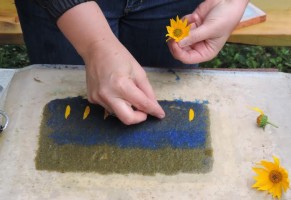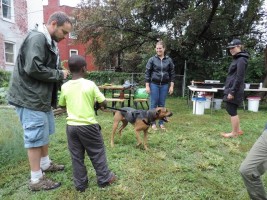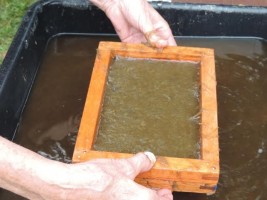By Kathy Bildner and Peggy Whetzel; photos by Kathy Bildner

For variety, Megan added some blue-dyed fibers and ox-eyed sunflower (Heliopsis helianthoides) to the original paper pulp. Click any image for a larger version.
With a generous dose of materials, expertise and patience, Megan Singleton led a free papermaking workshop in the McKinley Meadows garden at 2257 Missouri Street on Saturday, August 22. You may recall the day as one where outdoor events might be better attended in a boat. Although a downpour dampened the proceedings somewhat, 15 people, including six kids, got a chance to try their hand at making paper from native plants.
“People were very wet when they left,” said Megan. Her damp hair pinned up, she seemed unfazed by the weather. Nor did the rain discourage the kids from a friendly fight with a few peas picked from the community vegetable garden on the site.
To prepare for the workshop, Megan harvested leaves from copper iris (Iris fulva) and blue iris (Iris virginica) to get fiber for making paper. The plants were growing nicely in the native plant beds that were installed last spring with a Wild Ones grant.
Megan then chopped the leaves into one-inch segments and soaked them overnight. Next, the leaves were cooked in soda ash to remove the non-cellulose material from the fibers. Rinsing the resulting material until it no longer felt soapy, she processed it to separate the plant fibers.
There are three basic methods for doing so. The fibers can be mashed or beaten by hand, or whirred in a household blender. Or, for a smoother paper, processed with a Hollander beater which mashes the fiber instead of cutting it.
With the iris leaves literally reduced to a pulp, Megan mixed water, formation aid and the pulp together in plastic cement mixing vats purchased from a hardware store. The vats were set out in the garden for the workshop. Just so you know, Megan’s directions note that “okra slime” can be used as a formation aid.
To begin the papermaking, Megan directed the students to swoosh their hands through the slurry to mix the fiber evenly through the water. “Think underwater jazz hands,” Megan wrote in the directions she handed out. Sliding a mould and deckle into the mix, Megan demonstrated how to lift the device up through the watery mix to collect a layer of pulp, then let the water drain away. The mould is a frame with a screen; the deckle is an empty frame on top that keeps the pulp in place as it is removed from the slurry.
Then Megan showed how to couch or remove the drained pulp from the mould by turning it deftly onto a felt. The final step was squeezing or pressing out the excess water by rolling a brayer over the material. The paper-to-be was then left to dry. Everyone got a chance to make their own page or two.
Although the wet, grocery-bag-colored pulp looked somewhat unpromising at the end of the workshop, the material dried into sheets with beautiful strong fibers and bits of plant material layered throughout.

Megan, garden staff and a young neighbor relaxed after the workshop. The papermaking vats are on tables in the rear.
The following Saturday, August 30, Megan taught a book-making workshop using some of the hand-formed paper from the previous week as pages. The weather was nice!
If you missed the August workshop, Megan will teach papermaking again in the McKinley Meadows garden on September 19. This workshop will be less involved, but there are other perks – it’s part of a social occasion, the group’s BBQ Fundraiser, which will be held from 4 – 8 p.m. The barbecue itself is free; bring a side dish if you can, join in yard games and get to know the McKinley Meadows volunteers and their neighbors.
Then, on October 10, the final event of the season, “An Evening of Poetry,” will be held from 5 – 8 p.m. Please bring a chair.
The McKinley Meadows programs were made possible and free with the support of the Regional Arts Commission, St. Louis Wild Ones and St. Louis Earth Day.
About Megan Singleton:
Megan Singleton is a practicing artist and educator based in St. Louis, Missouri. She is adjunct faculty at Webster University where she teaches Papermaking and Studio Art Courses and has worked as a digital artist for Bruton Stroube Studios since 2005. She received her MFA in sculpture from Louisiana State University in 2012 and her BFA in Photography from Webster University in 2005.
Her installations crisscross the boundaries of contemporary craft, combining sculpture, hand papermaking, and digital applications. Her work explores the intersection of dendritic systems and patterns found in waterways, plants and paths of travel. She exhibits nationally and internationally in solo and group exhibitions. Megan serves on the advisory board of the hand papermaking organization Friends of Dard Hunter and she’s a member of the International Art Collective Expanded Draught, based in Galway Ireland.


